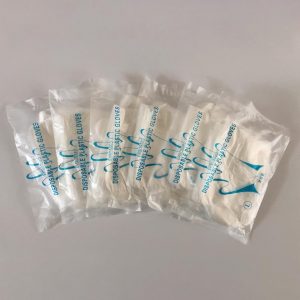Latex gloves, like many single-use plastic items, raise environmental concerns due to their impact on waste generation, pollution, and resource consumption. Here are some specific concerns related to latex gloves as single-use plastics:
- Waste Generation: The extensive use of single-use latex gloves across various industries, including healthcare, food service, and manufacturing, contributes to significant waste generation. When gloves are discarded after a single use, they end up in landfills, adding to the global waste problem.
- Biodegradability: Unlike some other single-use plastics, latex gloves are made from natural rubber latex, which is biodegradable under certain conditions. However, in many landfill environments where oxygen and sunlight are limited, biodegradation is slow. As a result, latex gloves may persist in landfills for a considerable period, still contributing to waste accumulation.
- Recycling Challenges: As mentioned earlier, recycling latex gloves can be challenging, especially if they are powdered or contaminated with other substances. The difficulties in recycling limit the opportunities to divert latex gloves from the waste stream, leading to increased environmental impact.
- Resource Consumption: Producing latex gloves requires natural rubber latex, a resource derived from rubber trees. The demand for disposable gloves can lead to increased rubber cultivation and harvesting, potentially impacting natural ecosystems and biodiversity.
- Marine Pollution: Improper disposal and littering of latex gloves, like other single-use plastics, can contribute to marine pollution. When gloves end up in water bodies, they can harm marine life, as animals might mistake them for food or become entangled in them.
- Microplastics: Although latex gloves are biodegradable, they can break down into microplastics during the degradation process. Microplastics have become a significant concern due to their potential to enter the food chain and their impacts on marine and terrestrial ecosystems.
Addressing these concerns requires a multi-faceted approach:
- Reducing Usage: Encouraging responsible glove usage and minimizing unnecessary use can help reduce the overall consumption of latex gloves.
- Alternative Materials: In certain applications where latex gloves are not necessary, switching to reusable gloves or gloves made from alternative materials like nitrile or vinyl can be more sustainable.
- Improving Recycling Infrastructure: Developing and expanding recycling facilities that can handle latex glove recycling can help divert them from landfills and extend their useful life.
- Awareness and Education: Educating users about the environmental impacts of single-use plastics, including latex gloves, can promote responsible use and disposal practices.
- Innovation: Encouraging research and development of more sustainable glove materials and manufacturing processes can lead to improved environmental outcomes.
By combining efforts to reduce single-use latex glove consumption, enhance recycling capabilities, and raise awareness, we can work towards minimizing the environmental impact of these products and move towards a more sustainable future.
















